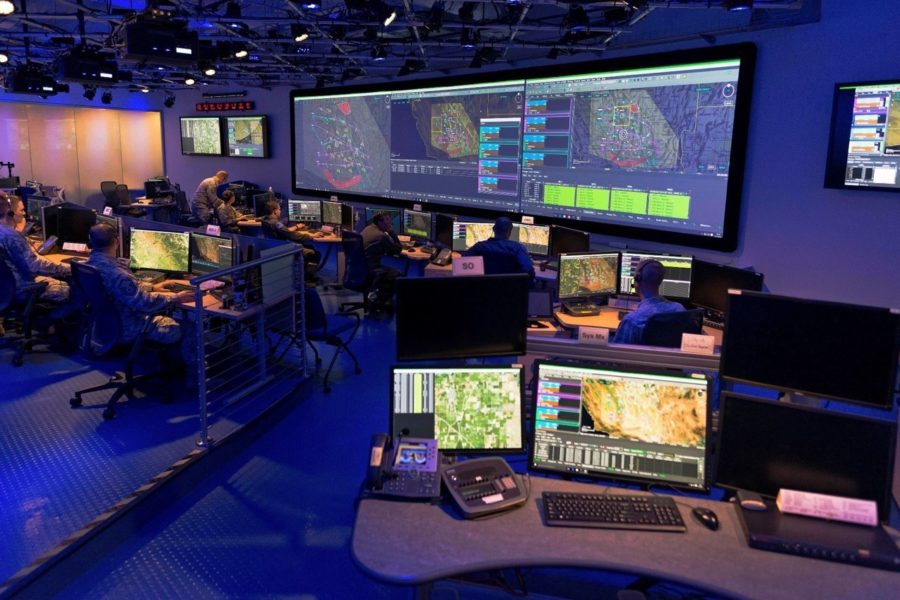The Department of the Air Force has identified 50 programs that will make up the core of its contribution to the Pentagon’s joint all-domain command and control concept, branding them part of the “DAF Battle Network,” according to newly-released budget documents.
The DAF Battle Network programs, which span multiple offices and agencies across the department, continue the evolution of the Advanced Battle Management System, the Air Force’s long-developing, ambitious attempt to replace a battle management aircraft with a network of systems and capabilitiesconnecting sensors and shooters around the world. ABMS investment is slated to accelerate. budget documents say, projecting $3.7 billion in research and development spending through fiscal 2028.
In 2024, the department is requesting $500 million for ABMS—not including millions of other dollars for programs identified related to the DAF Battle Network. Budget documents show ABMS funding rising in 2025 to $815 million, then peaking at $951 million in 2026, before dipping to $721 million in 2027 and $711 million in 2028.
Air Force Secretary Frank Kendall took aim at the highly experimental ABMS/JADC2 demonstrations when he became secretary, saying he saw them as falling short of his objective to deliver meaningful capability to warfighters in a finite period of time. Today, “operationally-focused ABMS” is one of his seven Operational Imperatives for the Air Force, and Brig. Gen. Luke C.G. Cropsey is the program executive officer for command, control, communications, and battle management (C3BM), perhaps the hardest job, Kendall says, he’s ever given anyone before. Cropsey, in effect, is responsible for defining and shaping the future of ABMS and JADC2 for the Air Force.
In a February interview with Air & Space Forces Magazine, Air Force Materiel Command boss Gen. Duke Z. Richardson said Cropsey was identifying the programs to include in that umbrella deciding what to leave out. At the AFA Warfare Symposium in early March, Cropsey shared with a panel of industry experts that his aim is to chart a course between today’s status quo and the dream of connecting every single sensor and shooter.
The Air Force’s 2024 budget documents lay out Cropsey’s path, pushing beyond earlier definitions of ABMS while trying to avoid duplication of effort across the department.
Cropsey “identified an initial set of 50 programs across the DAF that collectively comprise the core elements of the DAF Battle Network,” the budget document states. “The DAF PEO C3BM will work in partnership with the PEOs of these core programs to ensure the technical and programmatic integration necessary to achieve the required operational decision advantage needed.”
Those 50 core programs include programs under the Air Force’s Command, Control, Communication, Intelligence and Networks directorate; Digital directorate; DAF Rapid Capabilities Office; Space Force PEO for Battle Management, Command, Control, and Communication; Space Development Agency; Space Rapid Capabilities Office; the National Reconnaissance Office; the Missile Defense Agency; and more, budget documents state.
The ABMS portfolio under Cropsey includes four “thrust areas”:
- Architecture and Systems Engineering, which will define the common standards and technologies necessary to integrate programs into the DAF Battle Network
- C3BM Digital Infrastructure, which will cover programs that develop secure processing, connectivity, and data management
- C3BM Software and Applications, which includes the planned Could-Based Command and Control network, known as CBC2, to integrate air defense data to support homeland defense
- C3BM Aerial Networking, which includes ongoing work for the Airborne Edge Node, including Capability Release 1— aimed at enabling tactical aircraft to connect with command and control centers by turning airborne platforms such as the KC-46 Pegasus tanker into a data link.
Beyond that, Cropsey will have to coordinate with all those program executive officers to integrate them into the broader DAF Battle Network. At the same time, he’ll be responsible for the portfolio of programs still under ABMS, which will receive funding both for its own efforts and for the necessary technical work to integrate the other Battle Network programs.
“ABMS is therefore not just a weapon system platform or sensor,” the budget documents state. “It is the aggregate of materiel and non-materiel solutions to integrate the essential data network that connects and empowers current and future weapon system platforms and sensors to fight and win in the modern era.”
